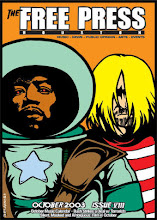The Princess and the Frog

We live in a time where one can say that the animation for The Princess and the Frog hearkens back to the hand drawn style of animation from the 20th century. The Princess and the Frog re-imagines the fairy tale The Frog Prince only striped of its grim possibilities while still painted with a constant dark palette of bayou colors. (Check out Shelley Duvall's Faerie Tale Theatre for a retro look at Frog Prince.)
In New Orleans during the early 20th century a humble black family makes do while an affluent white family lords over the Mardi Gras parade. Two young girls from each respective family are friends. We observe them briefly as kids, and then for most of the story as young adult women. During the Mardi Gras a prince visits New Orleans but he's tuned into a frog by a dastardly dude who hopes to gain occult power though his tomfoolery. The black characters are drawn in a manner that, with the exception of the voodoo characters, are more akin to the look of white people. But this is a Disney cartoon and everyone of importance becomes a frog after 15 minutes so the whole black/white issue is kind of moot. And because it's a Disney cartoon there is actually a spine to the universe it creates, as opposed to something like Cloudy With A Chance of Meatballs.
Special attention is devoted to the jazz era in which this movie takes place. The characters move with the hipness swing jazz commands. When our distaff protag finds herself up the bayou without a paddle (so to speak) she finds guidance from an introverted crocodile who just happens to be the best trumpet player in the French Quarter. And there's a firefly who adds a touch of soul to the proceedings. This unlikely bunch heads deep into the swamps with the enthusiasm of a Mark Twain adventure. Not unlike a spicy gumbo, The Princess and the Frog resembles a complex recipe that blossoms like a grand souffle.
The animation never tries to overstay its welcome. The backgrounds are always changing from tenement homes to mansions to shady groves to spooky shacks and finally back to opulence. We're constantly challenged by darker evocations of the bayou, the dangers of the backwoods and strange night parades in the Quarter. Some of the silhouettes recall the style of Tim Burton's creatures from Nightmare Before Christmas. It's interesting that Burton has as much influence over today's animated output as Mickey Mouse.
The music and songs by Randy Newman, while perfunctory, never produce a hit or even a tune you leave humming. The Princess and the Frog offers solid family fare although very young children will be freaked out by the progressively dark exteriors.









0 Comments:
Post a Comment
<< Home